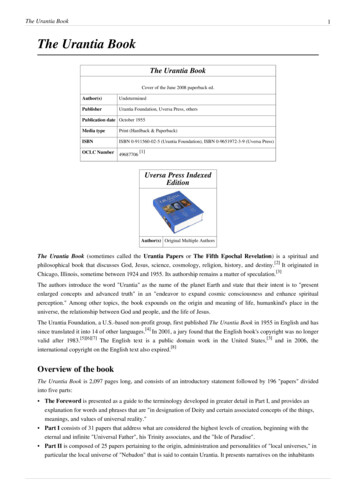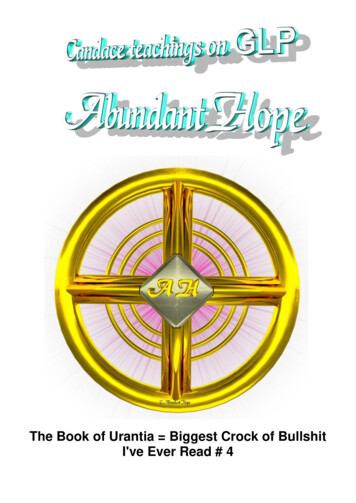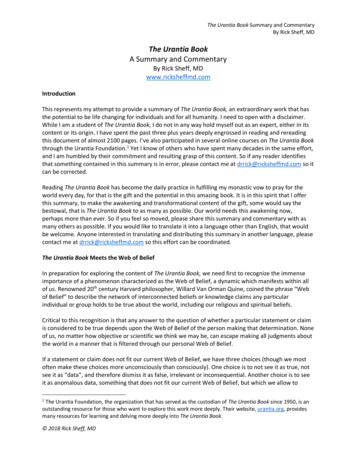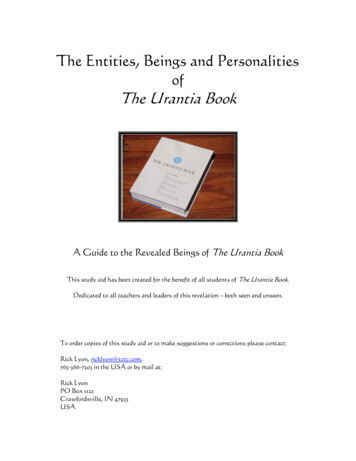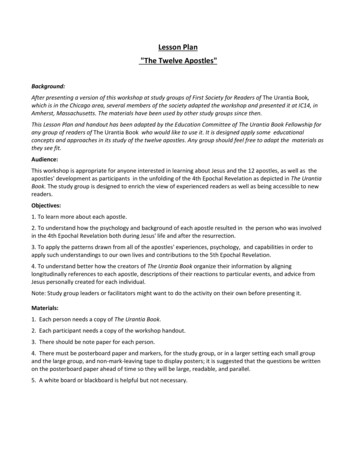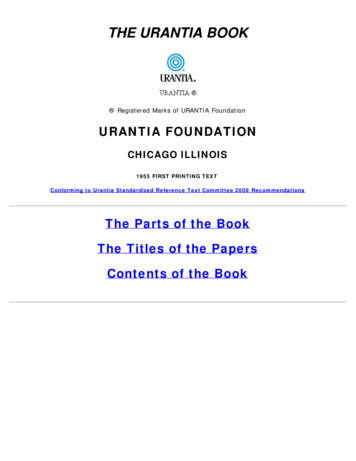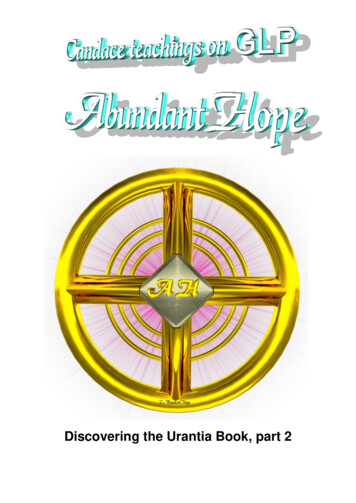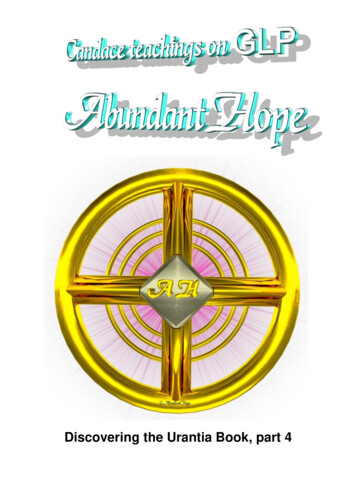
Transcription
WORK-IN-PROGRESS (AUGUST 1, 2020) PARALLEL CHART FORPaper 95 — The Melchizedek Teachings in the Levant 2011, 2012, 2015, 2020 Matthew BlockThis chart is a revision of the 2011, 2012 and 2015 versions.Most endnotes and Urantia Book cross-references have been deleted to enhance readability.Sources for Paper 95, in the order in which they first appear(1)Lewis Browne, This Believing World: A Simple Account of the Great Religions ofMankind (New York: The Macmillan Company, 1926)(2)James Henry Breasted, The Dawn of Conscience (New York: Charles Scribner’s Sons,1933)(3)Harold Peake and Herbert John Fleure, Priests and Kings (The Corridors of Time,Volume IV) (New Haven: Yale University Press, 1927)(4)Ernest F. Scott, The Kingdom of God in the New Testament (New York: The MacmillanCompany, 1931)(5)Robert Ernest Hume, Ph.D., The World’s Living Religions: An Historical Sketch (NewYork: Charles Scribner’s Sons, 1924)Note: Coded as Hume1.(6)Robert Ernest Hume, Ph.D., Treasure-House of the World’s Religions: Selections fromTheir Sacred Scriptures (New York: Charles Scribner’s Sons, 1932)Note: Coded as Hume2.Key(a)Green indicates where a source author first appears, or where he/she reappears.(b)Yellow highlights most parallelisms.(c)Tan highlights parallelisms not occurring on the same row.1
(d)An underlined word or words indicates where the source and the UB writer pointedlydiffer from each other.(e)Blue indicates original (or “revealed”) information, or UB-specific terminology andconcepts. (What to highlight in this regard is debatable; the highlights are tentative.)(f)Light green indicates Bible passages or fragments thereof, which are not paralleled in thesource text.2
SOURCE OR PARALLELWork-in-progress Version 3 jan. 2011 2011, 2012, 2015, 2020 Matthew BlockRevised 7 Feb. 2012, 13 Feb. 2015, 1 Aug.2020URANTIA PAPER 95PAPER 95 — THEMELCHIZEDEKTEACHINGS IN THELEVANTAs India gave rise to many ofthe religions and philosophies of easternAsia, so the Levant was the homeland ofthe faiths of the Occidental world.95:0.1The Salem missionaries spread out allover southwestern Asia, throughPalestine, Mesopotamia, Egypt, Iran, andArabia, everywhere proclaiming the goodnews of the gospel of MachiventaMelchizedek. In some of these lands theirteachings bore fruit; in others they metwith varying success. Sometimes theirfailures were due to lack of wisdom,sometimes to circumstances beyond theircontrol.1. THE SALEM RELIGION INMESOPOTAMIABOOK II: HOW RELIGION DEVELOPED IN THE ANCIENT WORLD, II:THE BABYLONIANS (Browne 65)1. The Semitic goddesses—how the Babyloniangods arose—trinities. (Browne 65)95:1.1 By 2000 B.C. the religions ofMesopotamia had just about lost theteachings of the Sethitesand were largely under the influence ofthe primitive beliefs of two groups ofinvaders,3
SOURCE OR PARALLELThousands of years ago, when some of[the bedouin Semites] struggled out of thebarren desert and obtained a foothold inthe lush meadows of Mesopotamia, theybrought with them their old desertreligion. It was then little more than acrude animism, with Ishtar, “SelfWaterer,” the spirit of the oasis, as thechief deity (B 66-67).[When these barbarian cavalrymen fromthe northeast overran the whole Euphratesvalley, they did not conquer the remnants ofthe Andites who dwelt upon the mouth of theriver on the Persian Gulf. [Etc.] (78:8.5)]URANTIA PAPER 95the Bedouin Semites who had filtered infrom the western desertand the barbarian horsemen who hadcome down from the north.4. The defects of the religion—polydemonism—aritualized morality—Shabatum and mythology—contrast with Hebrew versions of same—fear.(Browne 72)95:1.2 But the custom of the earlyAdamite peoples in honoring the seventhday of the week never completelydisappeared in Mesopotamia. Only,during the Melchizedek era,Taboos dogged [the Babylonians’] everystep in life, and “bad luck” threatenedthem at every turn. Every seventh daywas regarded as somehow “evil,”the seventh day was regarded as the worstof bad luck.and on it special sacrifices were fearfullyoffered and all manner of special tabooswere observed.It was taboo-ridden;For instance, the princes were forbiddento go forth on journeys that day, or to eatmeat cooked over a fire (B 73-74).it was unlawful to go on a journey, cookfood, or make a fire on the evil seventhday.4
SOURCE OR PARALLELIt is highly probable that the Hebrewsactually got their Sabbath from theBabylonian Shabatum, for we know theypaid little heed to its observance untilafter they had lived in exile in Babyloniafrom 586 B.C. to 536 B.C. But note howdifferently the Hebrews regarded the day.To them it was holy, not evil. TheHebrews told themselves that the Sabbathwas a divinely appointed day of rest, andthough they observed on it many of theold Shabatum taboos, they did so not outof fear of the genii but out of respect fortheir God (B 74).URANTIA PAPER 95The Jews carried back to Palestine manyof the Mesopotamian taboos which theyhad found resting on the Babylonianobservance of the seventh day, theShabattum.1. The Semitic goddesses—how the Babyloniangods arose—trinities. (Browne 65)95:1.3 Although the Salem teachers didmuch to refine and uplift the religions ofMesopotamia,But the [newly arrived] Babyloniansby no means contented themselves withmerely remodeling the old [desert] gods.They manufactured new ones, too—hundreds of them. Even to list the chief ofthem—Ningursu, Bel, Shamash, Nabu,Marduk, Anu, Ea, Sin, and the rest—would be quite tiresome. The idea of onegreat god with universal sway seemshardly to have occurred to the people (B68).they did not succeed in bringing thevarious peoples to the permanentrecognition of one God.Such teaching gained the ascendancy formore than one hundred and fifty yearsand then gradually gave way to the olderbelief in a multiplicity of deities.95:1.4 The Salem teachers greatlyreduced the number of the gods ofMesopotamia, at one time bringing thechief deities down to seven: Bel,Shamash, Nabu, Anu, Ea, Marduk, andSin.5
SOURCE OR PARALLELURANTIA PAPER 95At the height of the new teaching theyexalted three of these gods to supremacyover all others, the Babylonian triad:Occasionally not a single god, but a groupof three together was worshipped assuperior: Anu (sky), Bel (earth), and Ea(sea);Bel, Ea, and Anu, the gods of earth, sea,and sky.or Shamash (sun), Sin (moon), and Ishtar(the star Venus). . . . Age after age newtrinities of that sort arose (B 68).Still other triads grew up in differentlocalities,all reminiscent of the trinity teachings ofthe Andites and the Sumerians and basedon the belief of the Salemites inMelchizedek’s insignia of the threecircles.2. Ishtar and the sex rites—holy prostitution—astrology. (Browne 68)[contd] But from beginning to end, onedeity remained supremely popular at leastamong the plain people of Mesopotamia.That deity was Ishtar,Never did the Salem teachersfully overcome the popularity of Ishtar,95:1.5the great mother of the gods, the spirit ofsex and fertility, the very principle of lifeitself (B 68).the mother of gods and the spirit of sexfertility.[See B 70, comparing the cult of Ishtar with theprimitive Celtic cult of Bridget.]They did much to refine the worship ofthis goddess,In Babylonia and throughout theLevant the people seem to have boweddown to it inordinately, and sex rites inhonor of Ishtar—or Astarte, Ashtoreth,Isis, Cybele, Venus, and Aphrodite, as thegoddess was known in the variouslands—were counted of primaryimportance.but the Babylonians and their neighborshad never completely outgrown theirdisguised forms of sex worship.6
SOURCE OR PARALLELIn Babylonia itself it was required thatevery woman, rich or poor, should submitat least once in her life to the embraces ofa stranger. She had to wait in the courts ofa temple of Ishtar until some man boughther for an hour, and then she had todedicate to the goddess the wages earnedby her harlotry.URANTIA PAPER 95It had become a universal practicethroughout Mesopotamia for all womento submit, at least once in early life, to theembrace of strangers;this was thought to be a devotion requiredby Ishtar,Without performing that rite a womanwas imagined to be incapable of bearingchildren, and was therefore unfit to marry(B 68-69).and it was believed that fertility waslargely dependent on this sex sacrifice.95:1.6 The early progress of theMelchizedek teaching was highlygratifying until Nabodad, the leader of theschool at Kish, decided to make aconcerted attack upon the prevalentpractices of temple harlotry. But theSalem missionaries failed in their effortto bring about this social reform, and inthe wreck of this failure all their moreimportant spiritual and philosophicteachings went down in defeat.[See previous page.]95:1.7 This defeat of the Salem gospelwas immediately followed by a greatincrease in the cult of Ishtar, a ritualwhich had already invaded Palestine asAshtoreth, Egypt as Isis, Greece asAphrodite, and the northern tribes asAstarte.And it was in connection with this revivalof the worship of Ishtar that7
SOURCE OR PARALLEL[The Babylonian priests] had somehowhit on the idea that the constant changesin the heavens bear some subtle relationto the happenings here on earth. Allhuman souls were believed to be hitchedfor weal or woe to stars, and the chiefconcern of the priests was, therefore, stargazing.That sorry deceit called astrology, whichstill lures the feebler-minded among men,had its first development back there inBabylonia almost four thousand yearsago! (B 70)URANTIA PAPER 95the Babylonian priests turned anew tostargazing;astrology experienced its last greatMesopotamian revival,3. The priesthood—its vices—and virtues. (Browne70)After all, religion to the Babylonian wasnot a matter of noble sentiment, but a sortof complicated insurance business; and itspriestly solicitors and agents were, asAmericans would say, out to get “all therewas in it for them.” Their extortions,especially for fortune-telling, sometimesgrew so flagrant that kings had actually topass laws to control them (B 71).fortunetelling became the vogue, and forcenturies the priesthood increasinglydeteriorated.95:1.8 Melchizedek had warned hisfollowers to teach about the one God, theFather and Maker of all, and to preachonly the gospel of divine favor throughfaith alone. But it has often been the errorof the teachers of new truth to attempt toomuch, to attempt to supplant slowevolution by sudden revolution. TheMelchizedek missionaries in Mesopotamia raised a moral standard too highfor the people; they attempted too much,and their noble cause went down indefeat. They had been commissioned topreach a definite gospel, to proclaim thetruth of the reality of the UniversalFather, but they became entangled in theapparently worthy cause of reforming themores,8
SOURCE OR PARALLELURANTIA PAPER 95and thus was their great missionsidetracked and virtually lost infrustration and oblivion.95:1.9 In one generation the Salemheadquarters at Kish came to an end, andthe propaganda of the belief in one Godvirtually ceased throughout Mesopotamia.But remnants of the Salem schoolspersisted. Small bands scattered here andthere continued their belief in the oneCreator and fought against the idolatryand immorality of the Mesopotamianpriests.But it must not be imagined for amoment that the great priesthood ofBabylonia was unrelievedly lecherousand low. One cannot read their ancienthymns without realizing that at least someamong their band were men of what wevaguely call “spirituality” and “religiousinsight.” Most of those hymns are meremedleys of magic phrases, but others arepoems of amazing beauty. Indeed, certainof them ring with tones that are strikinglyreminiscent of the Hebrew Psalms. Forinstance:The sin which I sinned I knew not;My God has visited me in wrath.I sought help, but none took my hand;I wept, but none gave ear.To my God, the merciful God, I turn andpray;How long, O Lord! . . .O God, cast not away thy servant,But turn my sin into a blessing.May the wind carry away mytransgressions.Seven times seven are they—Forgive thou them! . . .Now this is no ordinary bit ofprimitive liturgy. It reveals a reverencefor the deity, a humility in the worshipper, [contd next pg.]9
SOURCE OR PARALLELand above all a freedom from magicalformula that would lead us to think it alla forgery did we not have the very stoneon which the Babylonian priests engravedit.URANTIA PAPER 9595:1.10 It was the Salem missionariesof the period following the rejection oftheir teaching who wrote many of the OldTestament Psalms, inscribing them onstone,where later-day Hebrew priests foundthem during the captivity and subsequently incorporated them among thecollection of hymns ascribed to Jewishauthorship.Such lines may not even be remotelytypical, but they are authentic. Andbecause they are authentic, and they andother lines of like quality were everwritten in Bel-Marduk’s courts, the cultof Babylonia must be seen to mark adistinct advance in the evolution ofreligion (B 71-72).These beautiful psalms from Babylonwere not written in the temples ofBel-Marduk;they were the work of the descendants ofthe earlier Salem missionaries, and theyare a striking contrast to the magicalconglomerations of the Babylonianpriests.[See 96:7.]The Book of Job is a fairly goodreflection of the teachings of the Salemschool at Kish and throughout Mesopotamia.95:1.11 Much of the Mesopotamianreligious culture found its way intoHebrew literature and liturgy by way ofEgypt through the work of Amenemopeand Ikhnaton. The Egyptians remarkablypreserved the teachings of socialobligation derived from the earlier AnditeMesopotamians and so largely lost by thelater Babylonians who occupied theEuphrates valley.10
SOURCE OR PARALLELURANTIA PAPER 952. EARLYRELIGIONEGYPTIAN95:2.1 The original Melchizedekteachings really took their deepest root inEgypt, from where they subsequentlyspread to Europe. The evolutionaryreligion of the Nile valley was periodically augmented by the arrival ofsuperior strains of Nodite, Adamite, andlater Andite peoples of the Euphratesvalley. From time to time, many of theEgyptian civil administrators wereSumerians. As India in these daysharbored the highest mixture of the worldraces, so Egypt fostered the mostthoroughly blended type of religiousphilosophy to be found on Urantia, andfrom the Nile valley it spread to manyparts of the world.XVII: THE SOURCES OF OURMORAL HERITAGE (Breasted 336)Gressmann goes even farther inidentifying foreign influences in theHebrew Psalms. He says: “The oldestmythological motif in the [Hebrew]hymns was that of the creation of theworld, and it (together with the creationmyth) probably originated in Babylonia.The motif of the divine care of the worldwas a later idea, which made its way intoPalestinian Psalmody under the influenceof Egypt” (JHB 368).The Jews received much of their idea ofthe creation of the world from theBabylonians,but they derived the concept of divineProvidence from the Egyptians.11
SOURCE OR PARALLELURANTIA PAPER 95BOOK II: HOW RELIGION DEVELOPED IN THE ANCIENT WORLD, III:THE EGYPTIANS (Browne 75)2. The idea of monotheism emerges. (Browne 77)Centuries before the Hebrews came upout of the night of desert savagery, wefind the Egyptians already groping theirway toward the idea of a monotheism, aOne God. It was political rather thanphilosophical considerations95:2.2 It was political and moral, ratherthan philosophic or religious, tendenciesthat impelled the Egyptians in such adirection.that rendered Egypt more favorable to theSalem teaching than Mesopotamia.As soon as some tribal chieftain managedto fight his way to the throne of the land,Each tribal leader in Egypt, after fightinghis way to the throne,sought to perpetuate his dynasty byso soon did he try to set his tribal god onthe throne of the heavens. Usually hetried to wipe [the defeated gods] out bydeclaring them to be merely so manyvagrant manifestations of his own deity.Or else his priests invented elaboratemythologies to prove that his god hadbeen the very first in the universe, andhad actually created all the other deities.Century after century such strategemswere resorted to (B 77-78).proclaiming his tribal god the originaldeity and creator of all other gods.In this way the Egyptians gradually gotused to the idea of a supergod, asteppingstone to the later doctrine of auniversal creator Deity. The idea ofmonotheism wavered back and forth inEgypt for many centuries, the belief inone God always gaining ground but neverquite dominating the evolving concepts ofpolytheism.12
SOURCE OR PARALLELURANTIA PAPER 951. Original animal-worship—the growth of thegods—the priests. (Browne 75)Of course, in very early times theEgyptians, like the rest of the primitivepeoples of the earth, were simple animists(B 75).95:2.3 For ages the Egyptian peopleshad been given to the worship of naturegods;Each tribe—there seems to have beenforty-two of them in Egypt about seventhousand years ago—worshipped thespirit inhabiting some particular speciesof living creature, and looked to it forprotection.more particularly did each of thetwoscore separate tribes have a specialgroup god,One worshipped the ram, another the bull,a third the lion; others worshipped theserpent, the cat, the goat, the ass, thefalcon, the hippopotamus, the pig, and thevulture.one worshiping the bull, another the lion,a third the ram, and so on.Evidently the earliest religion of Egyptmust have been a totemism rather likethat of the American Indians, each tribebeing named after the animal which itheld sacred, and which it may havelooked on as its spiritual ancestor (B 7576).Still earlier they had been totem tribes,very much like the Amerinds.IV: THE OLD KINGDOM OF EGYPT(Peake & Fleure4 61)The rich soon lined their tombs with sundried brick, to add to the comfort of thedeparted, while the poor were contentwith a simple pit, covered with a mat,which soon became silted up with sand.Now this sand was impregnated withnatron or soda, so that the bodies in thegraves became pickled while those in thebrick vaults gradually decayed. In duecourse this difference was discovered andits cause determined.95:2.4 In time the Egyptians observedthat dead bodies placed in bricklessgraves were preserved—embalmed—bythe action of the soda-impregnated sand,while those buried in brick vaultsdecayed.13
SOURCE OR PARALLELInstead, however, of abandoning brickvaults for graves, the rich experimented inmethods of pickling the corpses of theirrelatives in solutions of natron. Thus byslow degrees arose the custom ofmummification (P&F4 91).The preservation after death of the bodywas the great desire of the Egyptians, asit was believed that some kind of liferemained as long as the body was intact(P&F4 91).The first clear evidence that we have ofthe custom [of mummification], still in itsinitial stages, is in some of the tombs ofthe second dynasty. It was not, however,very successful, and the use of portraitstatues was to act as a substitute for thecorpse should the latter decay (P&F4 91).URANTIA PAPER 95These observations led to thoseexperiments which resulted in the laterpractice of embalming the dead.The Egyptians believed that preservationof the body facilitated one’s passagethrough the future life.That the individual might properly beidentified in the distant future after thedecay of the body, they placed a burialstatue in the tomb along with the corpse,[?]carving a likeness on the coffin.Later portrait-statues become commonerand reach their zenith during the fourthdynasty, when statues both in diorite andwood, of kings, queens, and nobles, attaina lifelike perfection never subsequentlyreached (P&F4 89-90).The making of these burial statues led togreat improvement in Egyptian art.95:2.5 For centuries the Egyptiansplaced their faith in tombs as thesafeguard of the body and of consequentpleasurable survival after death.14
SOURCE OR PARALLELURANTIA PAPER 95XIII: POPULAR APPROPRIATION OFTHE OLD ROYAL HEREAFTER ANDTHE GROWTH OF MAGIC (Breasted223)The belief in the efficacy of magic asan infallible agent in the hand of the deadman was thus steadily growing, and weshall see it ultimately dominating thewhole body of mortuary belief as itemerges a few centuries later in the Bookof the Dead (JHB 242).It is difficult for the modern mind tounderstand how completely the belief inmagic penetrated the whole substance oflife, . as much a matter of course assleep or the preparation of food (JHB247).The later evolution of magical practices,while burdensome to life from the cradleto the grave,most effectually delivered them from thereligion of the tombs.XIV: THE JUDGMENT HEREAFTERAND MAGIC (Breasted 250)Already in the Feudal Age the priestsinserted in the Coffin Texts a charm forthis purpose entitled:The priests would inscribe the coffinswith charm texts which were believed tobe protection against“Chapter of not Permitting a Man’s Heartto be Taken Away from Him in theNether World.”a “man’s having his heart taken awayfrom him in the nether world.”This charm was now included in the Bookof the Dead.Presently a diverse assortment of thesemagical texts was collected and preservedas The Book of the Dead.Here magic entered a new realm—But in the Nile valley magical ritual earlybecame involved with the realms15
SOURCE OR PARALLELthat of conscience, personal qualities, andcharacter. The unlimited possibilities ofgain made it inevitable that the priestsshould now take the momentous step ofpermitting such agencies thus to enter theworld of moral values. Magic mightbecome agent for moral ends (JHB 263).URANTIA PAPER 95of conscience and characterto a degree not often attained by therituals of those days.[?]And subsequently these ethical and moralideals, rather than elaborate tombs, weredepended upon for salvation.VII: THE NATURE GODS ANDHUMAN SOCIETY: OSIRIS (Breasted94)The superstitions of these timesare well illustrated by95:2.6The battle of Horus with Set, which, aswe recall, was a Solar incident, waged sofiercely that the young god lost his eye atthe hands of his father’s enemy. WhenSet was overthrown, and the eye wasfinally recovered by Thoth, this wise godspat upon the wound and healed it. Thismethod of healing the eye, which is, ofcourse, folk-medicine reflected in themyth, evidently gained wide popularity,the general belief in the efficacy of spittleas a healing agent,an idea which had its origin in Egyptpassed into Asia, and seems to reappearin the New Testament narrative, in theincident which depicts Jesus doubtlessdeferring to recognised folk-custom inemploying the same means to heal a blindman (JHB 102).and spread therefrom to Arabia andMesopotamia.In the legendary battle of Horus with Setthe young god lost his eye, but after Setwas vanquished,16
SOURCE OR PARALLELURANTIA PAPER 95this eye was restored by the wise godThoth, who spat upon the wound andhealed it.V: THE PYRAMID TEXTS ANDPHARAOH’S ASCENT TO THE SKY(Breasted 65)Two ancient doctrines of this celestialhereafter have been commingled in thePyramid Texts: one represents the dead asa star,95:2.7 The Egyptians long believedthat the stars twinkling in the night skyrepresented the survival of the souls ofthe worthy dead;and the other depicts him as associatedwith the Sun-god, or even becoming theSun-god himself (JHB 73).other survivors they thought wereabsorbed into the sun.[?]During a certain period, solar venerationbecame a species of ancestor worship.Much discussion has been caused by thefact that the sloping entrance passage ofthe Great Pyramid points directly towardsthe Pole Star.The sloping entrance passage of the greatpyramid pointed directly toward the PoleStarThe hitherto unnoticed reason isobviously disclosed in the Pyramid Texts.When the king’s soul emerged from thispassageso that the soul of the king, whenemerging from the tomb,its direction carried it straight towards thecircumpolar stars (JHB 73-74).could go straight to the stationary andestablished constellations of the fixedstars,the supposed abode of the kings.In the oblique rays of the sun, also,shooting earthward through some openingin the clouds,95:2.8 When the oblique rays of thesun were observed penetrating earthwardthrough an aperture in the clouds,they beheld a radiant stairway let downfrom the sky that the king might ascend.it was believed that they betokened theletting down of a celestial stairwaywhereon the king and other righteoussouls might ascend.17
SOURCE OR PARALLEL“King Pepi has put down this radiance asa stairway under his feet, whereon KingPepi ascended to this his mother, theliving Uræus that is on the head of Re”(JHB 78).URANTIA PAPER 95“King Pepi has put down his radiance asa stairway under his feet whereon toascend to his mother.”BOOK II: HOW RELIGION DEVELOPED IN THE ANCIENT WORLD, III:THE EGYPTIANS (Browne 75)5. The dead—the Judgment Day—the resort tomagic. (Browne 85)95:2.9 When Melchizedek appeared inthe flesh, the Egyptians had a religion farabove that of the surrounding peoples.It was believed that on death the soul of aman set out at once to reach a JudgmentHall on high. Evil spirits tried to waylayit on the journey, but any soul adequatelyprovided with magic formulae couldevade them all.With these spells the evil spirits could bedodged or fought off until finally the soulattained the Judgment Hall and stoodbefore the celestial throne of Osiris, theJudge.There it gave an account of itself to Osirisand his forty-two associate gods. Anysoul that could truly say: “I come beforeye without sin, and have done thatwherewith the gods are satisfied. I havenot slain, nor robbed, nor stirred up strife,nor lied, nor lost my temper, norcommitted adultery, nor stolen templefood. . . . I have given bread to thehungry, clothes to the naked, a ferry tohim who had no boat”—if in sincerity itcould say all that,then the soul was straightway gatheredinto the fold of Osiris.They believed that a disembodied soul, ifproperly armed with magic formulas,could evade the intervening evil spiritsand make its way to the judgment hall ofOsiris,where, if innocent of “murder, robbery,falsehood, adultery, theft, andselfishness,”it would be admitted to the realms ofbliss.18
SOURCE OR PARALLELURANTIA PAPER 95But if it could not, if it was found wantingwhen weighed in the heavenly balances,then it was cast into a hell, to be rent toshreds by the “Devouress.” For only therighteous souls, only the guiltless, werethought to be deserving of lifeeverlasting! . . (B 86-87).If this soul were weighed in the balancesand found wanting, it would be consignedto hell, to the Devouress.[contd] It was an extraordinary set ofbeliefs, and reveals a moral insight on thepart of the Egyptians that must have beenunmatched in the world of four thousandyears ago (B 87).And this was, relatively, an advancedconcept of a future life in comparisonwith the beliefs of many surroundingpeoples.XVII: THE SOURCES OF OURMORAL HERITAGE (Breasted 336)In contemplating Amenemope’spleasing picture of the two trees [seeExhibit A], one is inevitably reminded ofthe first Psalm:Blessed is the man that walketh not in thecounsel of the wicked, .And he shall be like a tree planted by thestreams of water,That bringeth forth its fruit in its season,Whose leaf also doth not wither,And whatsoever he doeth shall prosper.The wicked are not so,But are like the chaff which the wind drivethaway.Therefore the wicked shall not stand in thejudgment.It is important to notice that “thejudgment” appearing here is the onlymention of it in the entire Book of Psalms.This is a significant hint, for a judgmenthereafter, as we have already seen, wasthe contribution of Egyptian civilisation(JHB 365-66).95:2.10 The concept of judgment in thehereafter for the sins of one’s life in theflesh on earth was carried over intoHebrew theology from Egypt.The word judgment appears only once inthe entire Book of Hebrew Psalms,119
SOURCE OR PARALLELWe cannot doubt that Jeremiah wasacquainted with Amenemope’s picture ofthe two trees, and it must equally wellhave been known to the author of the firstPsalm (JHB 367).URANTIA PAPER 95and that particular psalm was written byan Egyptian.[Note: See 95:4.6, below, where the UB identifiesAmenomope as the author of the first Psalm.]3. EVOLUTION OF MORALCONCEPTSFOREWORD (Breasted ix)95:3.1 Although the culture andreligion of Egypt were chiefly derivedfrom Andite MesopotamiaIt is now quite evident that the ripe socialand moral development of mankind in theNile Valley, which is three thousandyears older than that of the Hebrews,contributed essentially to the formation ofthe Hebrew literature which we call theOld Testament. Our moral heritagetherefore derives from a wider humanpast enormously older than the Hebrews,and it has come to us rather through theHebrews than from them.The rise of man to social idealism tookplace long before the traditionaltheologians’ “age of revelation” began(JHB xv).and largely transmitted to subsequentcivilizations through the Hebrews andGreeks,much, very much, of the social andethical idealism of the Egyptians arose inthe valley of the Nile as a purelyevolutionary development.Notwithstanding the importation of muchtruth and culture of Andite origin, thereevolved in Egypt more of moral culture asa purely human development thanappeared by similar natural techniques inany other circumscribed area prior to thebestowal of Michael.20
SOURCE OR PARALLELURANTIA PAPER 9595:3.2 Moral evolution is not whollydependent on revelation.The fact that the moral ideas of earlymen were the product of their own socialexperience is one of profoundest meaningfor thinking people of today. Out ofprehistoric savagery, on the basis of hisown experience, man arose to visions ofcharacter (JHB xv).High moral concepts can be derived fromman’s own experience.Man can even evolve spiritual values andderive cosmic insight from his personalexperiential living because a divine spiritindwells him. Such natural evolutions ofco
Most endnotes and Urantia Book cross-references have been deleted to enhance readability. Sources for Paper 95, in the order in which they first appear (1) Lewis Browne, This Believing World:


